Artist Ólafur Elíasson and Alexander Ljung, Internet-Entrepreneur, Consider the Pulling Power of a Cluster of Creative Talent, a New Culture of Sharing, and the Bridge between Thinking and Doing.
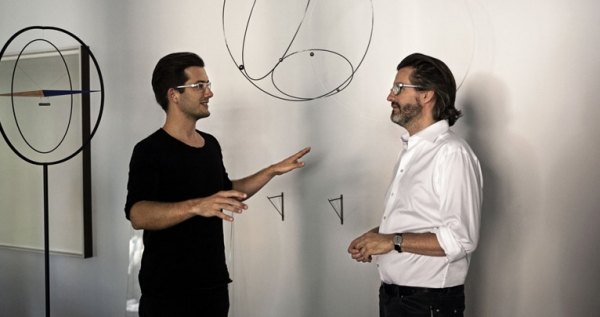
Alexander Ljung and Ólafur Elíasson met up at Elíasson’s studio in Berlin. The artist has converted a former brewery into an impressive base for his creative work – a mixture of workshop and laboratory in which his large-format technically and artistically demanding objects and installations take shape. As Elíasson spoke with the founder of model start-up SoundCloud, their words collided with the echoes of the artist’s team at work, so that at times communication was difficult. But it was a purely acoustic problem, because Elíasson and Ljung had plenty to say to one another – about the links between art, technology and new media, about the joy of experimenting and why certain places have a particularly inspirational impact at specific times. And why both art and business should not be pursued for their own sake but always in pursuit of a higher goal.
Alexander Ljung: Interesting, isn’t it, that we two Scandinavians should meet up in Berlin of all places. What brought you here, Ólafur?
Ólafur Elíasson: I could give you the easy answer and say that it was the attraction of Berlin’s strong artistic and creative community. But instead of just rolling that out again, let me dig a bit deeper: What happens when there is a strong community and why is this important for me as an artist? Historically, Berlin has so far been the only place in the world in modern history where a similar situation has arisen before. Approximately 100 years ago, there was a similar density of creativity in this city. There have been other peaks, for instance in Paris in the Twenties, or in New York in the Seventies, but the scale of the cluster of creativity in Berlin is unprecedented, just like it was 100 years ago. Such a mass creates very fertile ground for experimentation, creativity and artistic challenges. Here there are not just one or two responses to all kinds of artistic or creative challenges but hundreds. And when you have very big groups of talent in the same place, the quality tends to go up. Such a community can create a focused talent mass. I’ve been here for 20 years now. I’m getting close to having spent half of my life in this city.
Ljung: For my part it was Berlin’s unique networking of art, technology and media theory that attracted me. Some people were building interactive installations; some people were trying to experiment with interfaces and different ways of interacting; and some people had a purely artistic way of looking at things. When we were still in Stockholm with SoundCloud and were confronted with very specific questions – some technical, some more musical – there was very often someone in Berlin who was working on precisely that topic. For some time now I’ve been deeply interested for example in how to visually represent sound.
I found a great book on the subject and, guess what? The author was based in Berlin. This happened several times. But when we decided to found our company here, it was a very spontaneous decision. We just visited for one day and then decided: Okay, we are moving to Berlin next week. With hindsight I could come up with a lot of smart reasons why that was the right move, but in reality it was just pure “it feels good”. Part of it was Berlin as a city and part of it is the density of artists and creative people here. It felt like it had this almost counter-culture vibe, where everybody can just come and do their own things. We didn’t think much about geography. We were just at a starting point, saying: In our mind there is a fundamental piece of the internet that is missing, so let’s go and create that. And it felt like Berlin could help us do that. How was it 20 years ago when you moved here? Was it the same then or different?
Elíasson: At that time a lot of people were moving to the city; it was very much about arriving. Berlin consisted of a lot of open spaces, things that had not found their final form or their form in any sense. So there were plenty of inbetween places; the city was more a gap between two tiers than the two tiers themselves. People were not just busy sorting out their position and identity; they were also busy sorting out the context in which that had to happen. The lack of intentionality in public space, for instance, simply allowed for a very diverse understanding of what the word “public” actually meant. Can we turn this piece of sidewalk into a gallery, into a theater, into a little poetry festival? You suddenly had a situation where the artists’ studios and the streets would merge – not just opening up but also re-inventing what public space would mean. This created a meeting ground where literature, theater, performing arts, language arts such as poetry as well as singing, and artists would meet as equals. That was a very healthy exercise for young people, particularly because the early Nineties were also emerging from a crisis where the art market of the late Eighties had collapsed in London, New York, Paris and so on. This led to quite a high degree of confidence in the idea that creativity would sustain itself successfully without the commercial platforms. It was certainly very liberating as there were no borders. But it was also a challenge, because you needed a border to sustain contextual language. So it did actually demand a lot from the artists.
Ljung: I think you see that in Berlin today as well. Having no boundaries is very liberating but it’s also one of the most stressful things, especially if you are trying to create something. At least for me, not having any limitations is a real challenge. It’s also the idea of space being open or not defined. What that basically means is that it is claimable, right? So anybody can take over a storefront and say: I claim that this is now an art gallery, and I am going to turn it into a public space. I’ve seen others, especially start-ups, that got lost. For some people the boundless freedom of being able to think and try out whatever they like leads them to lose touch with the rest of the world and get caught up in their own ideas. Compare that with San Francisco, for example, where I live part of the time: there, people are very set on thinking about the impact of their actions and how to translate them into something useful for a lot of other people. Sometimes that’s missing here. So how do you strike a balance between absolute freedom and focusing on the process of creativity? This is probably quite different for the two of us …
Elíasson: I’m not sure. There is a journey between thinking and doing; there is a process of taking a thought or an idea, a concept, a feeling, or maybe even intuition, and translating it into action. I think your compass on that journey is very much related to your social grid or the social stamina, the sense of humanistic trajectory, or the values by which you address why you want to do something. You combine theory and practice in a way in which your deeper convictions become the motivator. In that sense I think there is an overlap, because what drives the relationship between thinking and doing in everything is really one’s values. And in Berlin in particular we also have this relatively strong, robust relationship with academia in social sciences. You can have your knowledge, then you have this thought of doing something combined with a strong “humanistic agenda”. This, I think, spills over into a lot of other things.
“Today an entrepreneur with an idea can radically shift things, so that even a company that is one of the largest in the world can disappear in just a few years.” - Alexander Ljung
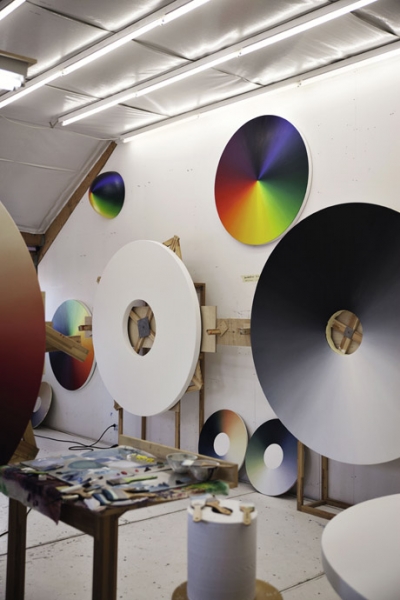
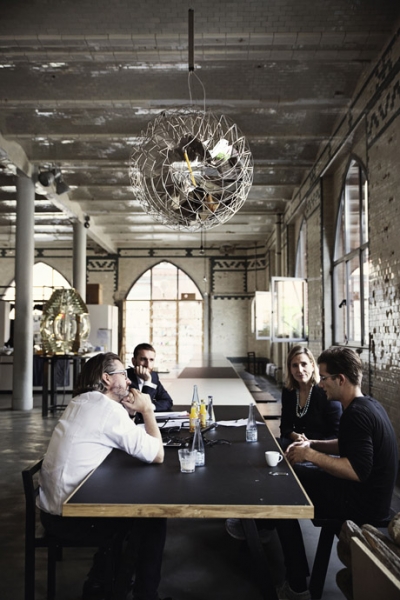
Is it a studio? Is it a lab? Hélène Reltgen, Egon Zehnder Paris, and Mark Krymalowski, Egon Zehnder Berlin, joined Alexander Ljung on a visit to Ólafur Elíasson’s home base in Berlin.
Ljung: That’s right! We too have had these discussions about the different intentions of start-ups. Even though they are usually fuelled by technology, there tend to be two different categories of companies. One is fundamentally driven by purpose and values and then the entrepreneur finds an economic engine to make it sustainable. The other set of companies start from a completely different basis: they are fuelled from the start by the economic engine, and then they try to figure out how to build the purpose around it. My partner Eric Wahlforss and I didn’t start SoundCloud as a business just for its own sake. We had a fundamental, personal sense of purpose. The framework of our company is just the vehicle through which we are pursuing it. But we are also finding how hard it is to focus on that purpose as the business grows and becomes more commercially successful. To be creative on this scale we need to step back from time to time and ask ourselves: What were our core values? What are the more abstract higher-order principles behind the business that enable us to make it happen with a whole team?
Elíasson: I think that with any project, no matter if it’s commercial or artistic, as the process goes on you have to stop and ask yourself questions about the meaning and purpose of the whole thing.
Ljung: The Berlin scene makes it easier to be a purpose-driven entrepreneur. A lot of companies here start from purpose rather than from the business side. It also attracts a lot of people who are very practical, who are doers and creative at the same time. Because there has been a major shift in how software applications – and especially socially-based software applications – are created. Formerly it was more like a classical assembly line; today it has completely reverted to an iterative way of working, where parts of the software work very well and at the same time others fail completely and have to be revised. Everything is more interactive, more iterative and more chaotic. It requires a different kind of thinking; we are constantly having to adjust. The whole team works in a way where we learn by doing and changing things along the way. Yet at the same time we also need to find the guiding principles that weave it all together.
“We thought nature was untouchable, because we saw it as something outside our own reach. We need to find platforms on which we nurture care, criticality and responsibility.” - Ólafur Elíasson
Elíasson: One thing that has struck me is that, especially in the process of decision-making, there has been an influx of values. I guess it started some 20 years ago with the notion of social corporate values and CSR. The definition of “success” also has become much more diversified so that success criteria are increasingly based on soft skills rather than on hard skills.
Of course there is also a need to express why we are doing things. I think the general big “why” is a “why” driven by interdependence and the need for understanding the responsibility that comes with being dependent on each other. “Interdependent” doesn’t necessarily mean “agreeing or sharing the same ideas” but it means “sharing regardless of whether you hold the same idea or not”. I am talking about a shared view that somehow suggests that we can be plural and singular at the same time. This concept is very difficult to understand for some older generations, because in the past the world was much more divided into groups with different attitudes and opinions. If you belonged to one group you couldn’t simultaneously advocate or approve of the opinions of, say, a party generally considered “the opposition”. Today there are a lot of spaces in the world which we can share. The interdependence that I am talking about is one which is closer to the doing than to the thinking. To come back to the decisions made in a process, the quality of the underlying set of values only becomes evident once it is executed. You could have a dogmatic set of values with regard to what you think about the world, but the impact would only be a theoretical one. The frictional impact actually comes out of then doing what you are thinking.
Ljung: I often get that feeling when I visit traditional firms or meet with their representatives. You can walk into their hallway and there they have their values clearly stated on a poster, very professionalized, so precise, so pinpointed that everybody can work with it. But along the way these values completely lost their meaning, and the whole purpose got lost. The employees will be able to answer the question “What are your values?” very clearly, but nobody takes ownership and they don’t practice what they preach. So ultimately it has no real impact for the business! In my view it is much more important how somebody acts. I think a lot of start-ups are grappling with two things: how to create some kind of clarity around values so they will help to guide people without losing the essence of it. Traditionally, I think, businesses have not been very good at that. You have to approach it with a really strong sense of purpose and then it works.
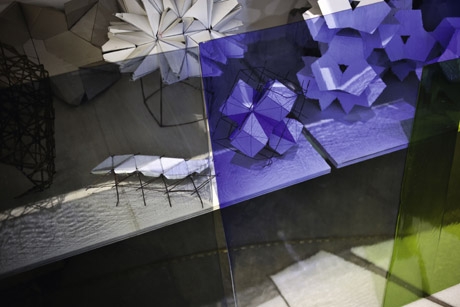
Elíasson: And what’s your role in this process as CEO?
Ljung: What I am not is the magician who comes up with all the answers, tells everybody what to do and then monitors execution. In a start-up that is constantly changing there are a lot of practical tasks where I as CEO have to be in some ways a curator of many different ideas and help people simplify, articulate and understand the purpose of it. Basically I just manage the balance between creative chaos and a little bit more structure, where it is needed. You too work with teams on your art projects, so how do you keep your value-driven system alive? How do you uphold the values or adapt them?
Elíasson: An artist’s studio for me is a reality machine. That means I take upon myself the challenge of producing reality. I do this in the context of the world and by doing so I of course co-produce and shape the world. I do not see myself as a kind of avant-garde in terms of being disconnected from reality, but rather in close dependence with the world. This means that the contact between the studio and the outside world is really enormous. There is a large amount of communication, typically in project management, which bounces back and forth. That contact also has to reflect the quality of the decisions happening in the studio when making a work of art. In contrast to all commercial operations, however, the decisive thing is that, within that process, I never make a decision in order to optimize profit or please a client. Of course sometimes while realizing a project I have to accept pragmatic restrictions, but the decisions I make are designed purely and simply to produce the best possible work of art. The client knows this, and this is the contract I have with reality: what I bring into the world cannot be made to fulfill a desire that the world already has. The moment I said: “Oh, I made that decision to optimize profits for my studio,” my clients would immediately stop buying the work. Why? Because when people come to my studio they are looking for the type of trust that bridges the thinking into the doing. They might be looking for a work of art as well, but the deeper reason is they are fine-tuning or reconsidering their values. My experience is that art is playing a less and less marginalized role in society. I see the most diverse people from all sectors coming into my studio asking questions, not because they think we do something far from reality but because they think we have shared agendas or values or projects.
Ljung: That is precisely the metric by which we measure our own success: impact. My general principle is, how many people we are impacting and how deeply we are impacting them. I fundamentally believe that SoundCloud has very unique properties in evoking emotions with people; it creates unity and connections between people. Today, twelve hours of music and audio are uploaded every minute. Ninety percent of tracks get played, most on the day that they’re posted. And more than half within one hour of being posted.
Elíasson: I like this idea of impact but I think successful art work starts when one can maintain a content-driven trajectory, meaning that we do not formalize for success. Sometimes an artist might have a sudden success with one type of work and we very often see that this artist then follows that path to success and starts repeating himself, just in different colors or scales of something, turning formalistic. We definitely have to stay away from that. The next grade would then be the degree to which you impact in terms of developing a movement, creating a dependence, or contributing to a discourse. And suddenly there is a situation where we feel a vibrancy that pushes people to do things disregarding rational justification. Suddenly, participating is inspiring you; you are actually being fed from the outside, making your next work of art, which is different from the first one. You are inside an evolution, so to speak, and it is very organic.
“We had a fundamental, personal sense of purpose. The framework of our company is just the vehicle through which we are pursuing it.” - Alexander Ljung
Ljung: Yes, I’m sure the tendency to keep on repeating a successful recipe can be found just about everywhere. But in today’s technological world the security that it promises is illusory. Today an entrepreneur with an idea can radically shift things, so that even a company that is one of the largest in the world can disappear in just a few years. That forces the industry to keep trying to change things, to make something new all the time and not just repeat the same thing. On your second point about impacting people and how you recognize that: for me real encounters with people – be it a teenager with his first guitar or a famous musician – who tell me how they use SoundCloud give me a true feeling for our impact. I take those individual samples (and trust that they are enough to get the right feel) and merge them with the abstractions and data of 200 million people to try and understand what our impact actually means at scale. And your third point about creating a movement – well, that’s the ultimate thing!
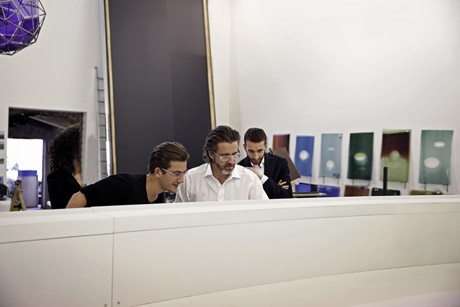
“I am talking about a shared view that somehow suggests that we can be plural and singular at the same time.” - Ólafur Elíasson
Elíasson: What I do is I construct spaces in which situations arise. The people in these situations bring their memories and their expectations, meaning the past and the future, and what I then hope to facilitate is a kind of dual type of experience that allows you to reconnect with where you came from and to connect with where you are going. If I didn’t call myself an artist, people would maybe think of me as a therapist. What I am interested in therapeutically is in showing that experience is something one can construct. This means that the quality of a certain atmosphere on the street or in a certain house or maybe in nature is constructed to a greater extent than we think. And when something is constructed it is much more likely that it can be changed. But if our surroundings and our senses are – at least to a large extent – constructed, you suddenly address the idea of self-awareness and the fact that you bear the responsibility for your surroundings rather than thinking that you are just consuming them. So this concept twists the authorship around, suggesting that the viewer is to some extent the artist or co-author.
Ljung: Everything around us is constructed in many different ways, yet I think that a lot of people will believe that it is a) consciously constructed and that it is b) consciously constructed by somebody else – which is not the case at all! The inputs are not consciously constructed by anybody else – each individual constructs his or her own reality. We deal with that in a very concrete way. Each individual practically creating their account is very much part of what SoundCloud is. They upload a piece of music; they contribute, so they are very much creating that environment. We construct the fundamentals of the spaces, but in the long term we are completely dependent on how people decide they want to use SoundCloud and how they want it to be or if they maybe even want to turn to something else. Then it would be like a big empty house that we have built up, but with nothing in it anymore.
Elíasson: That’s an interesting concept. Do you see it as a privilege or a burden to get the huge amount of feedback you mentioned?
“We have seen the loss of trust. And that is why there is a lot of attention right now on the best systems to link the common sense of yesterday with what we are going to depend on tomorrow.” - Ólafur Elíasson
Ljung: The baseline is that it is a privilege to get it, because nobody will take the time to tell you something unless they actually care about what is going on. No matter if they are saying something good or bad, they care. It means we have impacted somebody to the point where they react. But in some ways it is also hard to then take that input and really operationalize it, when you deal with a lot of scale.
Elíasson: When you care you are at least in a situation where you do not feel indifferent. People who are indifferent, in the sense that they don’t care, are a huge threat to the societies of today. This is a great challenge with regard to motivation and education. We have major fields of science that are now focusing on empathic and inclusive systems. Caring also comes with a degree of critical capability; critical to the point of being precise with regard to what your values are. So through caring you also transport your point of view. This is where I think art can facilitate – not the criticality of the artist, which I hope is also in there somewhere; but of the responsive viewer or people responding in a critical way. That’s why I often return to our relationship with nature in my work. We have to realize that nature is also constructed. We thought nature was untouchable or the climate was untouchable, because we saw it as something outside our own reach. I think this is where we need to find – and this is something that creativity also addresses – platforms on which we nurture care, criticality and responsibility.
Ljung: I think we have an imbalance in the world in terms of what people care about and how. Creativity is one thing we can use to shift that into a better balance. Getting somebody to care is like explaining something in a compelling way so that people understand why they need to care about it.
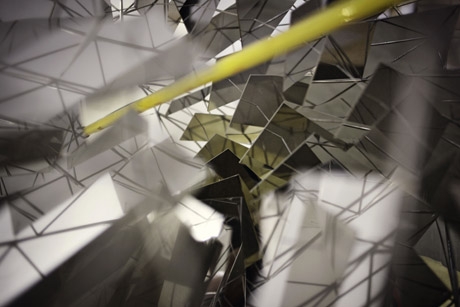
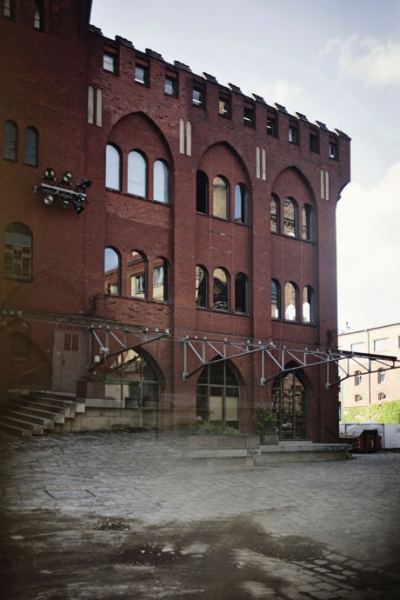
The façade of the venue signposts the industrial past of this building in Berlin’s Prenzlauer Berg district.
Elíasson: Of course we also need to ask ourselves how do we know that the quality and the values of today will be relevant tomorrow, and what produces some contingency between what was yesterday and what will be tomorrow? We have seen the loss of trust in the markets, loss of trust in the political system, loss of trust in the democratic system in general. And that is why there is a lot of attention right now on the best systems to link the common sense of yesterday with what we are going to depend on tomorrow. I think that culture and art in particular is one of the things that will create these connections, because it is based on a different chain of values. We need to address sameness instead of differences, and based on the concept of sameness we should build a sustainable economic model – one that still needs to be market-driven. I am not at all skeptical about market principles as such, but I think that in this way new languages need to be shaped globally. They need to be synchronized; they need to be mutually comprehensible – in form and content, and in values.
Ljung: On a macro level we have gotten to a point where more people than ever before feel a need for a strong individual sense of purpose. When that’s not fulfilled, they fall into indifference. I think that is precisely the challenge that future leaders face – to formulate purpose and meaning.
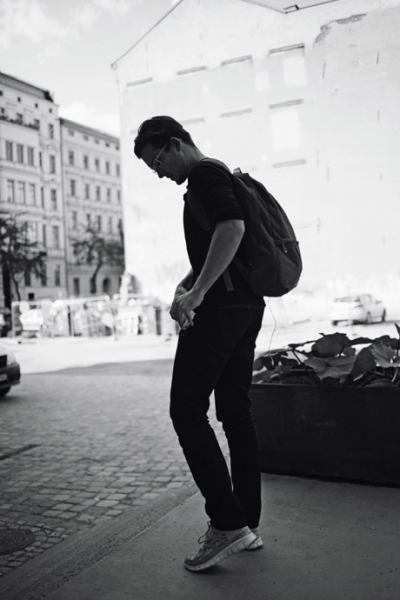
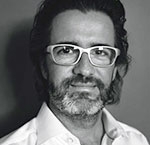
Ólafur Elíasson,
ranks among the most important of all contemporary artists. He is known world-wide for his grand installations that often use cityscapes, the elements and weather as materials. Elíasson’s artworks are often interpreted as an appeal for a more responsible approach to the environment. Elíasson was born in Copenhagen in 1967; both his parents are natives of Iceland. He studied at the Royal Danish Academy of Fine Arts from 1989 to 1995. In 1994 he moved to Berlin. Some of Elíasson’s best-known works are: The Weather Project (2003), which turned the Turbine Hall of the Tate Modern in London into an artificial atmosphere of fine, illuminated mist. For The New York City Waterfalls (2008) he installed four huge artificial waterfalls in East River. Elíasson has received many awards for his work. In 2006 he won the Danish Crown Prince Couple’s Award with a purse of DKK 500,000. In October 2013 he was presented with the prestigious Goslarer Kaiserring. And in that same year, together with Danish architect Henning Larsen, he won the European Union Prize for Contemporary Architecture, also known as the Mies van der Rohe Award, for their work on the Harpa Concert Hall in Reykjavík.
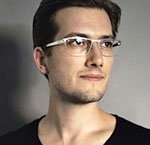
Alexander Ljung,
born in 1981, is the founder of SoundCloud. SoundCloud is today the world’s leading audio platform that gives users unprecedented access to the world’s largest community of music and audio creators. As a teenager, Ljung developed a passion for music and music production. He studied engineering with a focus on computer and interface technology in Stockholm. While at university he met his future business partner, the artist Eric Wahlforss, in a computer lab. One of the projects that arose from their joint work was a sharing system for musicians called SoundCloud. They soon realized that SoundCloud could be to music what YouTube was to video – an online space for creating, sharing and debating. In 2007 Ljung moved to Berlin. In 2008 Ljung launched SoundCloud with co-founder and CTO Eric Wahlforss. As CEO, Ljung is responsible for SoundCloud’s vision, overall strategy and leadership, overseeing a global team of over 200 people. SoundCloud was featured as one of Fast Company’s “2012 Most Innovative Companies” for giving the internet a voice. The start-up won the European Commission’s Europioneer Award and was named Best International Startup.





